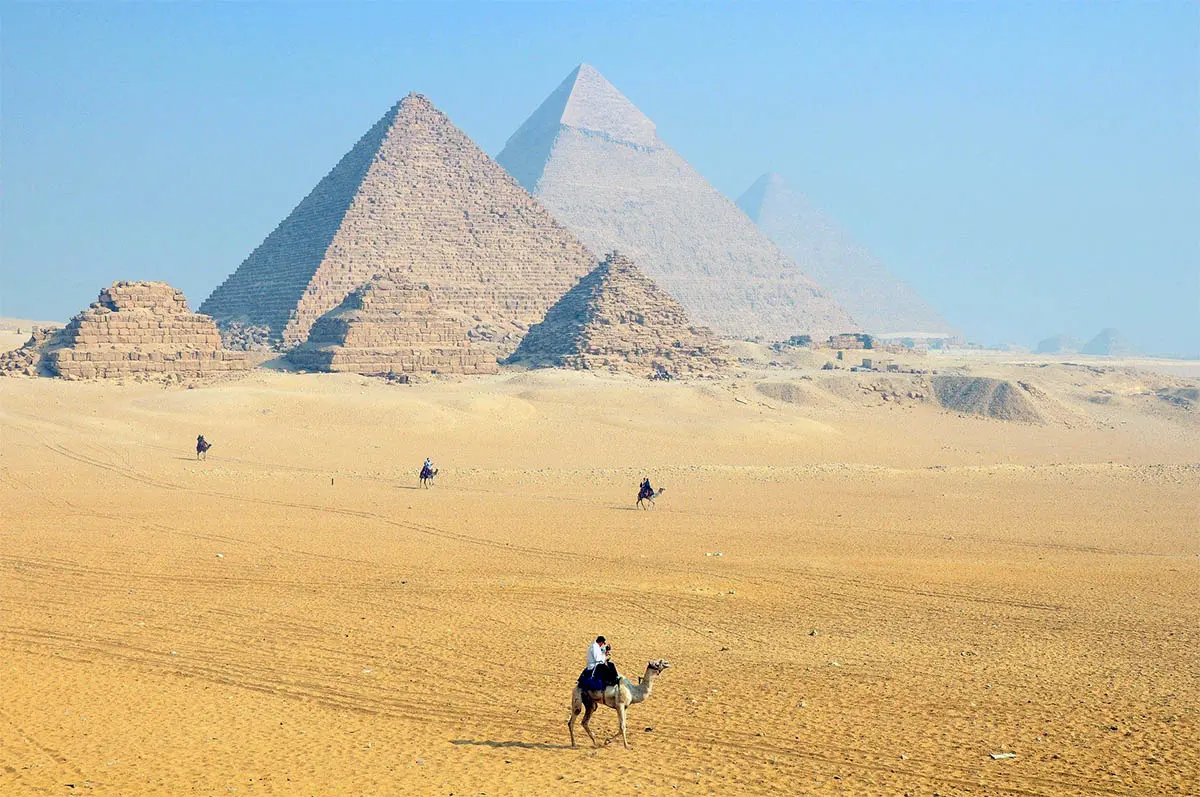
Audio 1 - Introduction:
Welcome to Cairo! Our audio guide (audio guides, audio tour) will accompany you throughout your visit to the Egyptian capital to show you the highlights of the city. Thousands of years of civilization have left so rich a legacy and so many treasures that a few days would not be enough to discover them all!
With 20 million inhabitants, Cairo is the most populous city in Africa, and it is a vibrant, dynamic, spectacular city. In the streets of the Egyptian capital the memories of the ancient era of the pharaohs and the Islamic tradition of the country converge.
The Nile flows through the city and Cairenes love to go out for dinner on one of the boats that ply the river. After an intense day of sightseeing, you can always seek refuge from the hubbub in one of its cafes, smoking a sisha or simply sipping a refreshing "karkade," the hibiscus tea that can be drunk hot or cold and is so popular that it has been elevated to the status of a national drink.
The visit begins!
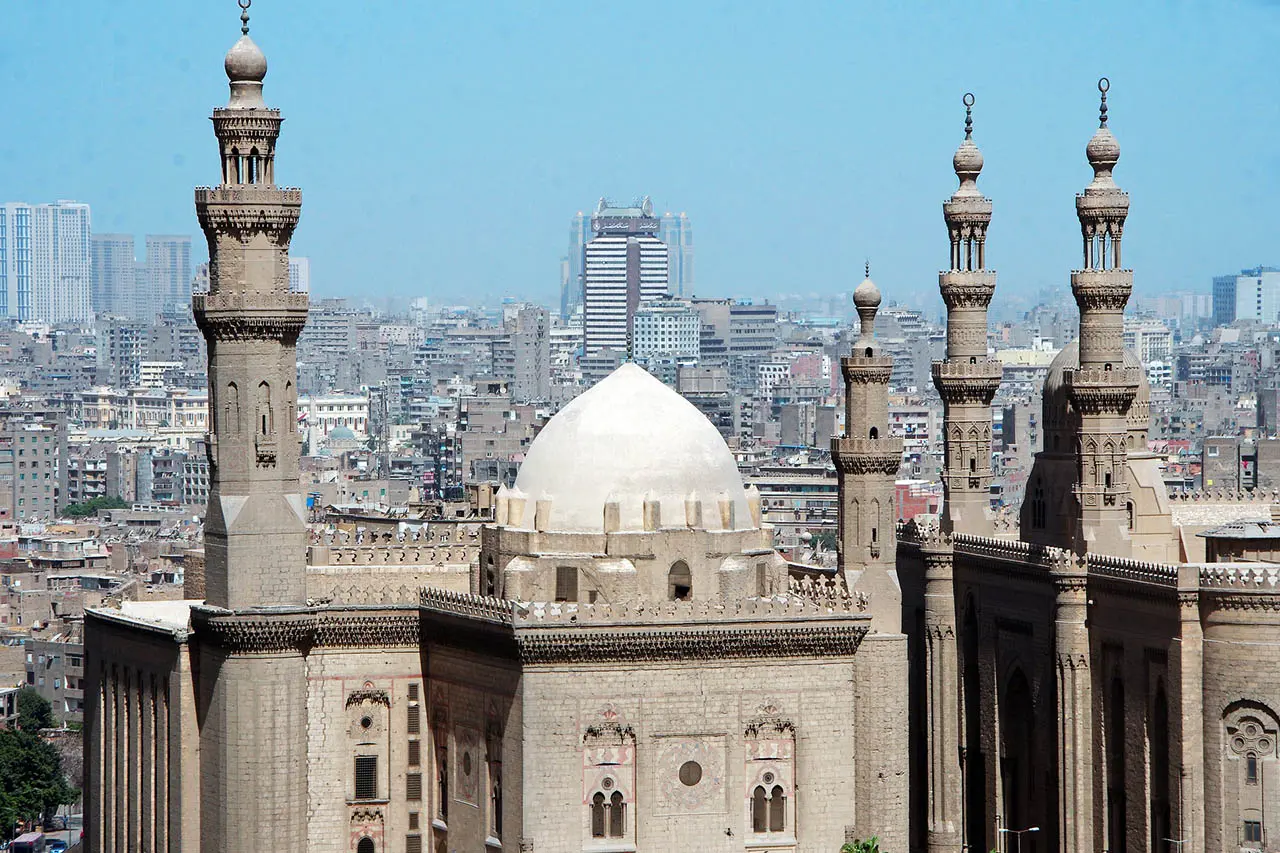
Audio 2 – The Pyramids of Giza:
On the Giza plateau, located about 20 kilometers from Cairo, stand the three pyramids of Giza: Cheops, Chephren, and Mykerinos. Since they were erected more than 4000 years ago, they continue to amaze travelers, being the subject of numerous theories and constituting one of the most magical places in the world.
The tallest, Cheops, is one of the seven wonders of the ancient world, along with the gardens of Babylon, the temple of Artemis, the statue of Zeus, the mausoleum of Halicarnassus, the Colossus of Rhodes, and the lighthouse of Alexandria. However, Cheops is the only one of these wonders that is still preserved today. You can find out more about it in the following audio guide (audio guides, audio tour) section.
Giza is also the largest necropolis of ancient Egypt, with burials dating back to the first dynasties. It reached its maximum splendor during the fourth dynasty, when the three pyramids were erected, along with funerary temples, piers, processional roads, and numerous mastabas of members of the royal family. At the end of the Ancient Empire, during the sixth Dynasty, there were several hundred tombs in Giza.
Guarding the 3 pyramids, the Great Sphinx of Giza was carved into the rock of the plateau. Its face is believed to represent the pharaoh Chephren.
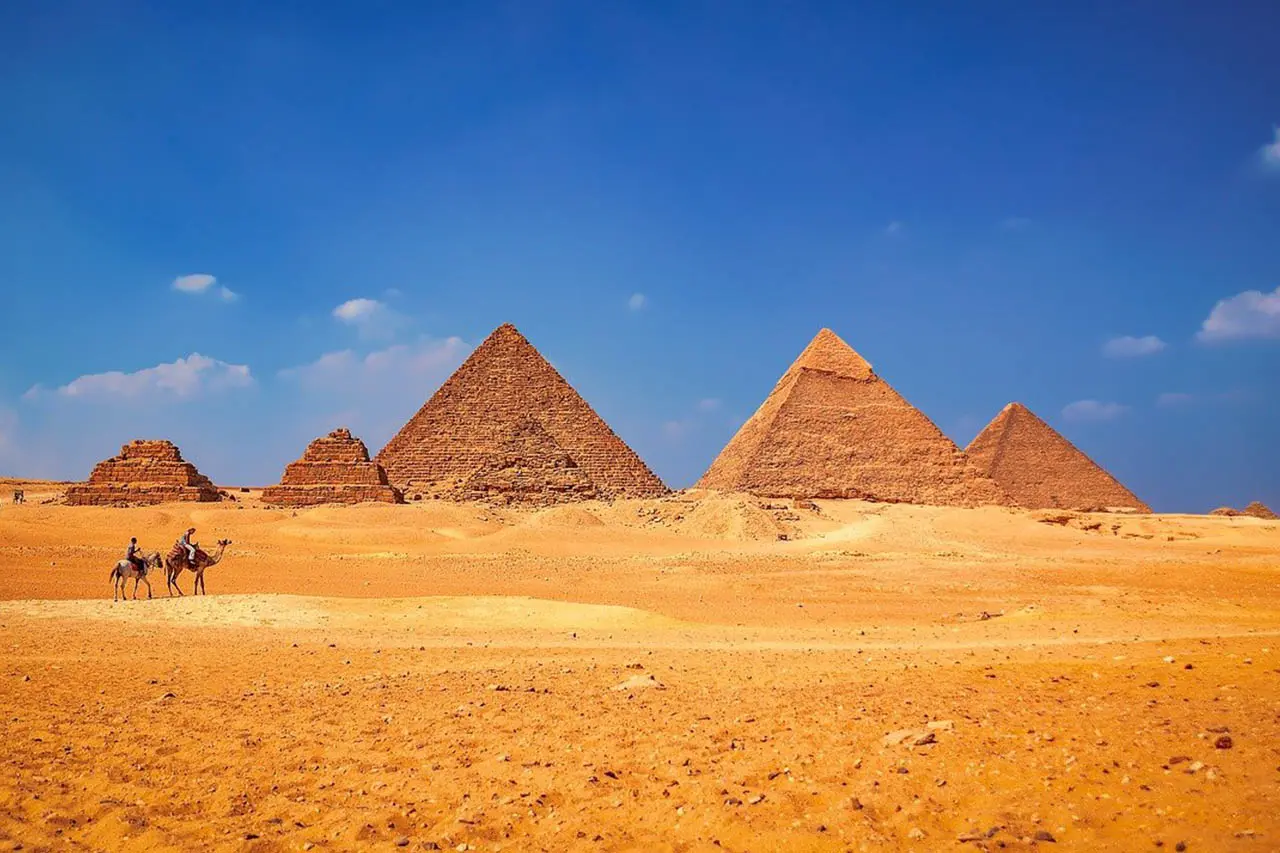
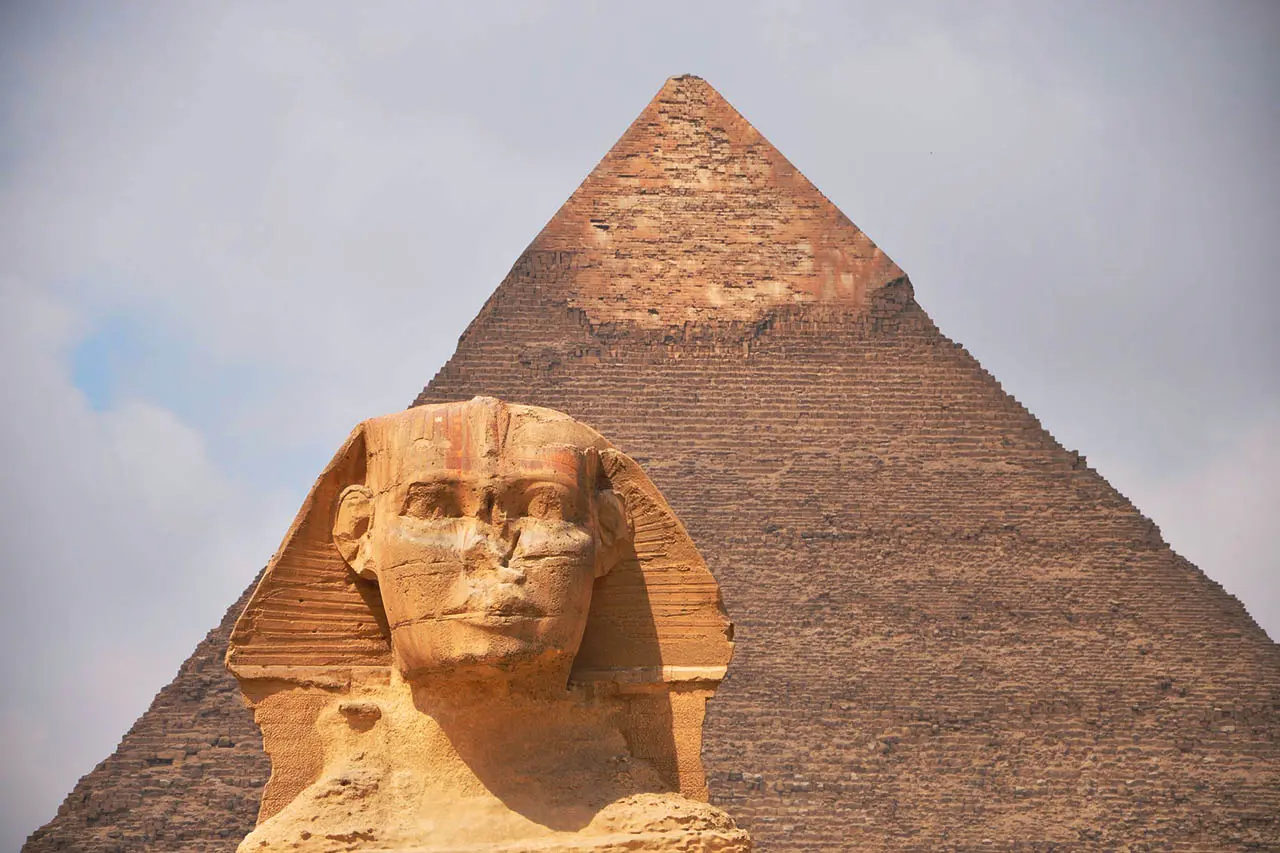
Audio 3 - The Great Pyramid (Pyramid of Cheops):
Next stop of the audio guide (audio guides, audio tour) is the Great Pyramid of Giza, also known as the pyramid of Cheops, or Khufu, the largest of the three. It is 140 meters high and its base is 230 meters, with a perimeter of almost one kilometre.
It was ordered to be built by Pharaoh Cheops of the fourth dynasty of Ancient Egypt, and it is estimated that 100,000 workers and 27 years were necessary to complete the work, estimating that it was completed between 2550-2570 BC. It was originally covered with white limestone blocks, and maintained this aspect until the early fourteenth century, when an earthquake detached part of the limestone coating that the Ottoman Turks later used for the construction of various buildings in Cairo.
It was the tallest building on Earth for 3,800 years, until it was surpassed by Lincoln Cathedral in England in the 14th century, and the tallest stone building in the world until well into the 19th century, when it was surpassed by the spire of St. Nikolai's Church in Hamburg.
The pyramid is composed of three main chambers, two located inside the pyramid, currently called the king's chamber and the queen's chamber, and one in underground, the subterranean chamber. The chambers were accessed from the north side, through a descending passage that connected with two passages, one ascending, which leads to the Great Gallery, and another descending, which reaches the subterranean chamber.
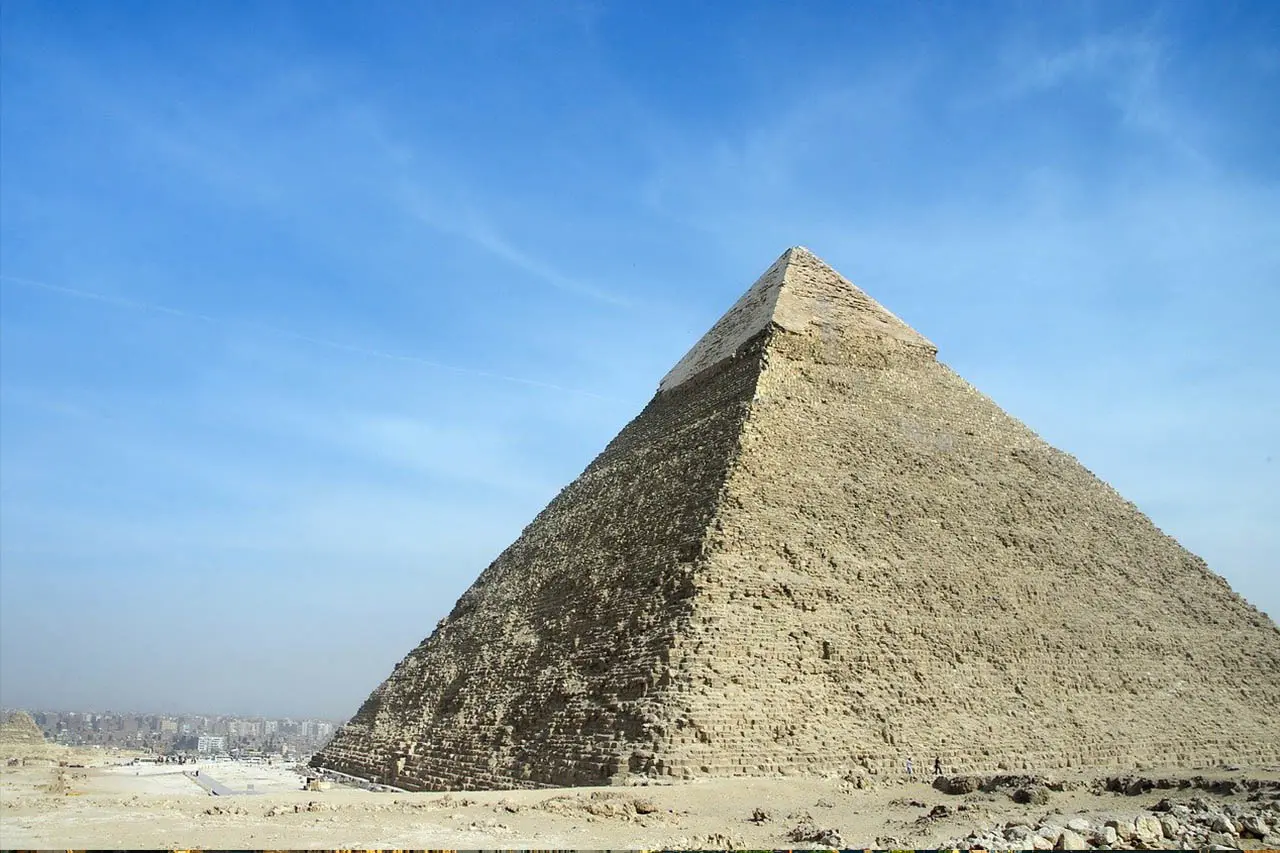
Audio 4 – the Al-Azhar Mosque:
Since its foundation and up to the present day, the Al-Azhar Mosque has been a center of learning. It is the second oldest Islamic university in the world and the most important in the teaching of Islamic law (Sharia), which is still attended by theology students from all over the world.
To understand the great political influence of this mosque, we must know that political, religious, and legal issues are debated there, and the laws that will later be extended to the rest of the Islamic world are dictated. The Grand Imam Sheikh of Al-Azhar is considered the highest authority in Islam.
The mosque was built between 970 and 972 by order of Gawhar al-Siqilli, who in 969 founded Al-Qahira (Cairo) as the royal city of the Fatimid caliphate when its power extended from Tunisia to Egypt.
One of the theories about the name of this mosque says that it was named after Fatima, the daughter of Muhammad, who was known as "al-Zahra," "the luminous one."
The architecture of this religious building is closely linked to the history of the city, since many of the extensions that were made over time reused elements of ancient temples from different periods. Also, the various cultures that dominated Cairo over the centuries left their mark on this mosque. This is how today with the audio guide (audio guides, audio tour) we see Roman columns, Pharaonic pillars, Coptic reliefs, Byzantine mosaics, and Persian arches.
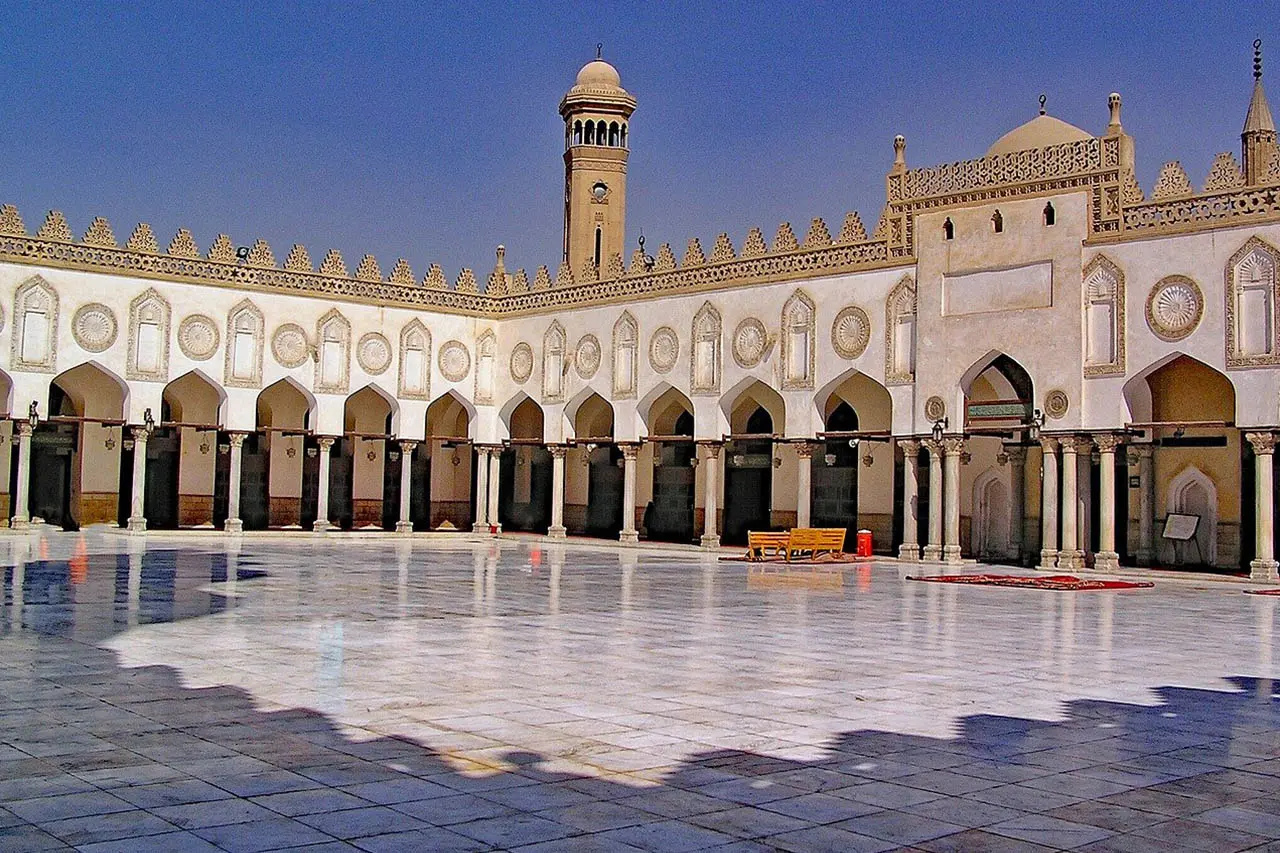
Audio 5 - The Egyptian Museum and the Grand Egyptian Museum:
In 1835, the Egyptian Antiquities Service was created to protect the country's treasures and monuments. Thereafter, the government assembled a collection of Egyptian Art. It was not until 1902 that the Egyptian Museum opened its doors, during the reign of Khedive Abbas Helmi II. It is located in the center of the city, in Tahrir Square.
At the time of its creation, the museum had about 12,000 pieces. Over the years, the collection grew considerably, to some 150,000 objects, and the museum ran out of space.
So that the collection can shine in all its splendor, the Great Egyptian Museum was built, which complements the current one, becoming the largest archaeological museum in the world. It is located 2 km from the Giza plateau, a stone's throw from the famous pyramids.
Among the precious objects in the collection of both museums you can see statues, paintings, reliefs, sarcophagi, jewelry, funerary elements, and numerous other objects. Two areas are particularly noteworthy in the audio guide (audio guides, audio tour): the first houses the treasures found in the tomb of Tutankhamun, in total about 5,000 objects, including the golden mask. The other room of special relevance is that of the mummies, where lie the mummified remains of the most important pharaohs between 1552 and 1069 BC, including Ramses II.
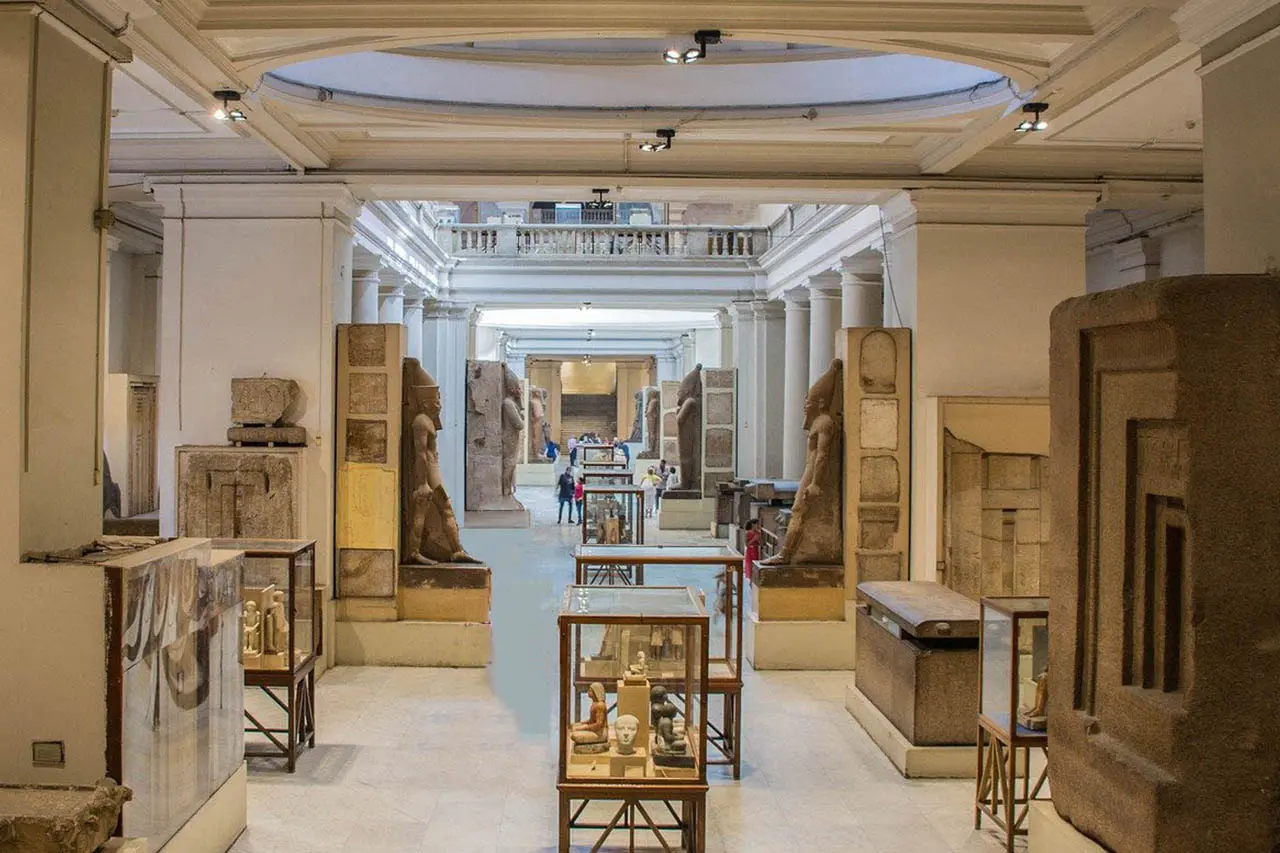
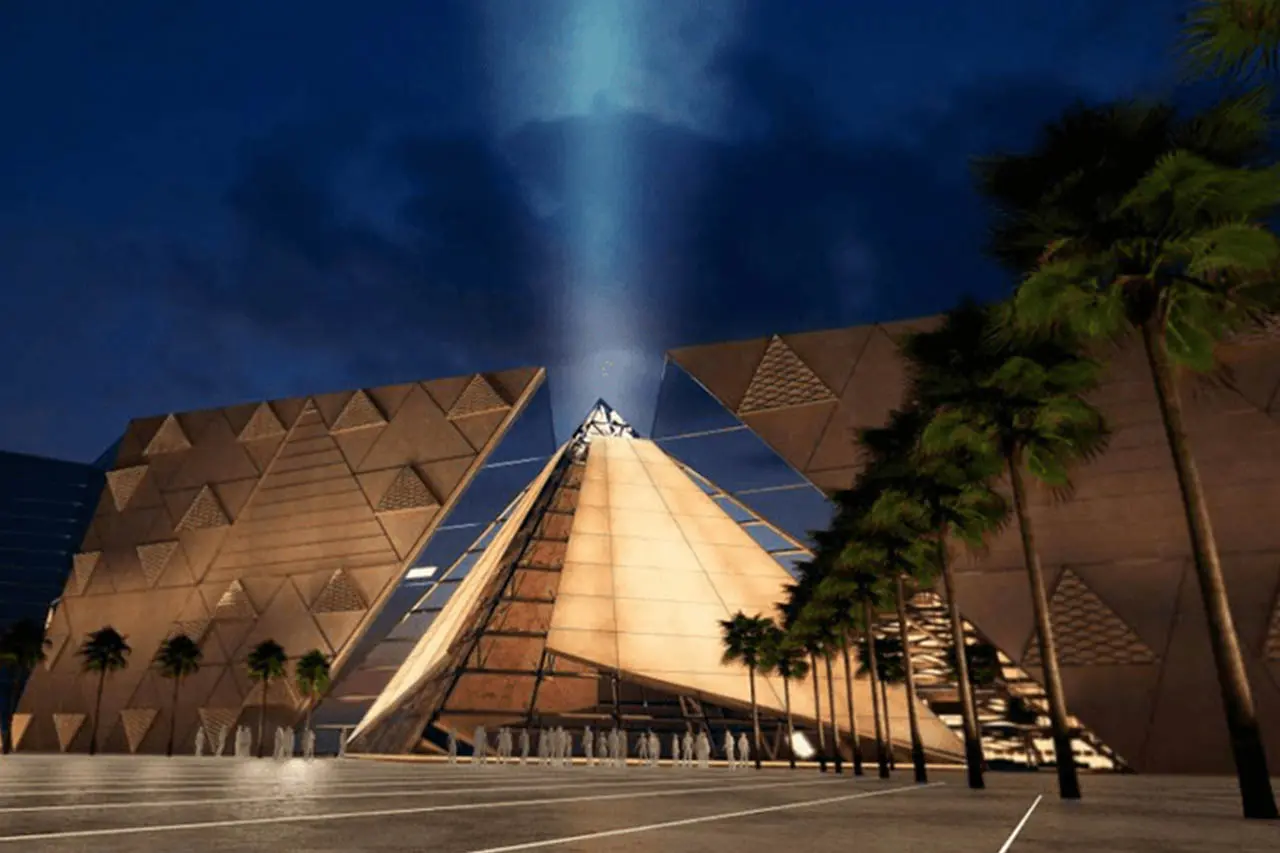
Audio 6 – Khan el-Khalili:
Khan el-Khalili is the largest market in Cairo. The bazaar is noisy, crowded, colorful and exciting. Souvenirs, spices, perfumes, fabrics, carpets, gold... No trip to Cairo would be complete without a visit to Khan el-Khalili! Even if you are not looking for shopping, it's still quite fascinating to discover its charm and flavor by walking through its winding alleyways.
Its origin dates back to 1382, when Emir Dyaharks el-Khalili ordered the creation of a place where merchants could display their merchandise and store their horses and cargo. Better known as a caravanserai, it still survives in some of the streets of the Khan el-Khalili such as Badestan or Sikka Khan el-Khalili, which the audio guide (audio guides, audio tour) strongly recommends visiting.
Today, the market has been significantly modernized, but there are still parts that show the original Mamluk-style architecture, which featured large arcades and vaulted ceilings.
In addition to stores, these streets are also home to charming tea shops, a restaurant where you can taste a kebab or buy a typical sweet of the country, and numerous cafes. In fact, el-Fishawy is the oldest cafe in Cairo, decorated with large mirrors and antique furniture, which used to be frequented by Naguib Mahfouz, the Egyptian author who won the Nobel Prize.
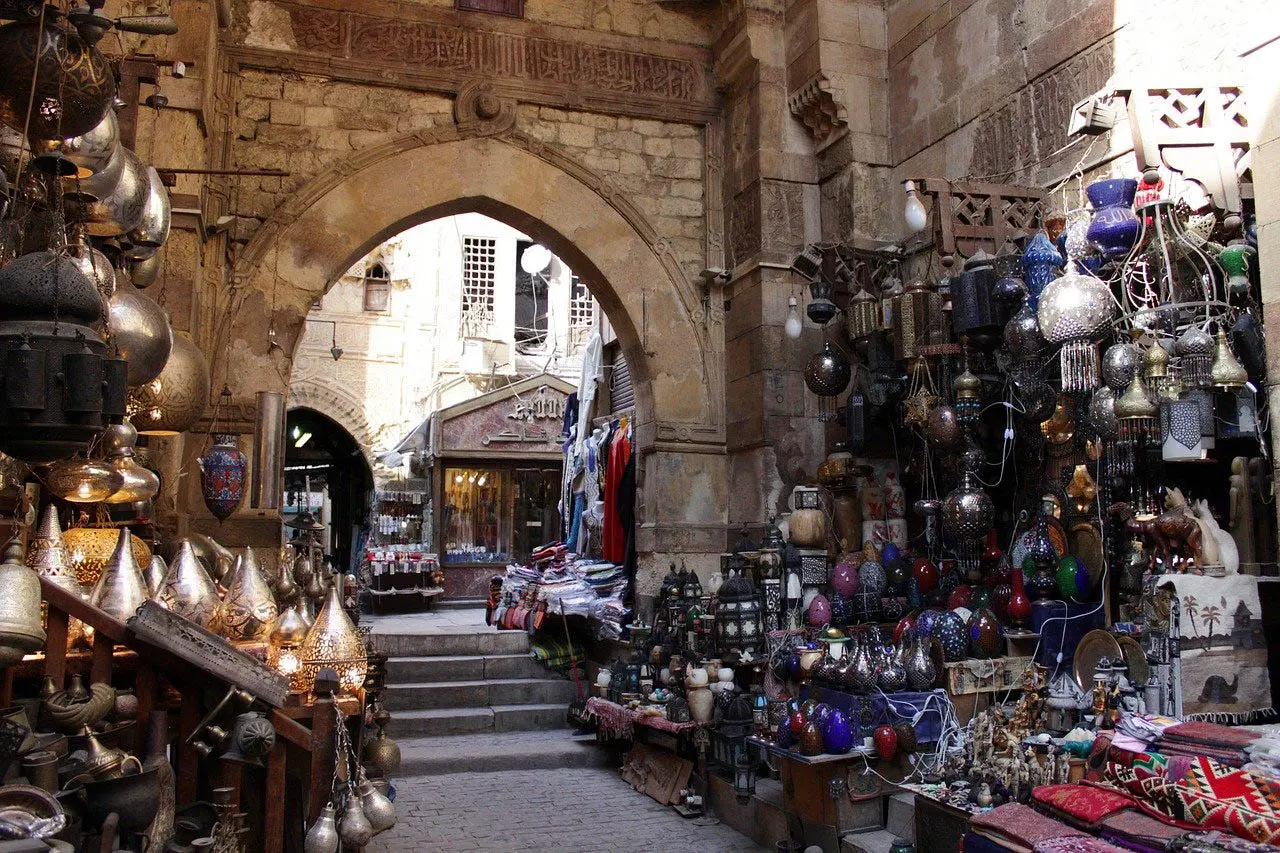
Audio 7 – the Saladin Citadel:
The Saladin Citadel is probably the best known non-pharaonic monument of the Egyptian capital. It is a medieval fortification from the Islamic era, with large and imposing gates, towers, and high walls for defense. At the time of its construction, it was among the most impressive and ambitious military fortification projects of its day.
In addition to the initial Ayyubid-era construction begun by Saladin in 1176, the Citadel underwent significant development during the Mamluk Sultanate that followed, culminating in the building projects of Sultan An-Nassir Muhammad in the 14th century. In the first half of the 19th century, Muhammad Ali demolished many of the older buildings and built new palaces and monuments, giving it much of its present form.
Today it is a preserved historical site. It houses three mosques, including the mosque of Mohammed Ali, whose audio guide (audio guides, audio tour) you can listen to in the next section. There are also several museums, including the National Military Museum.
The citadel also houses the imposing Gawhara Palace (the Palace of Jewels), named after Gawhara Hanem, the last wife of Mohammed Ali. Beautiful gold inscriptions adorn the walls of this majestic Ottoman-influenced palace.
To the west and southwest of the Citadel was a long open field called by historians the "hippodrome" or the "Maydan" ("square" or "block"). For centuries, it was maintained as a training ground, especially for horsemanship, and as a field for military parades. Its outline is still visible in the layout of the roads.
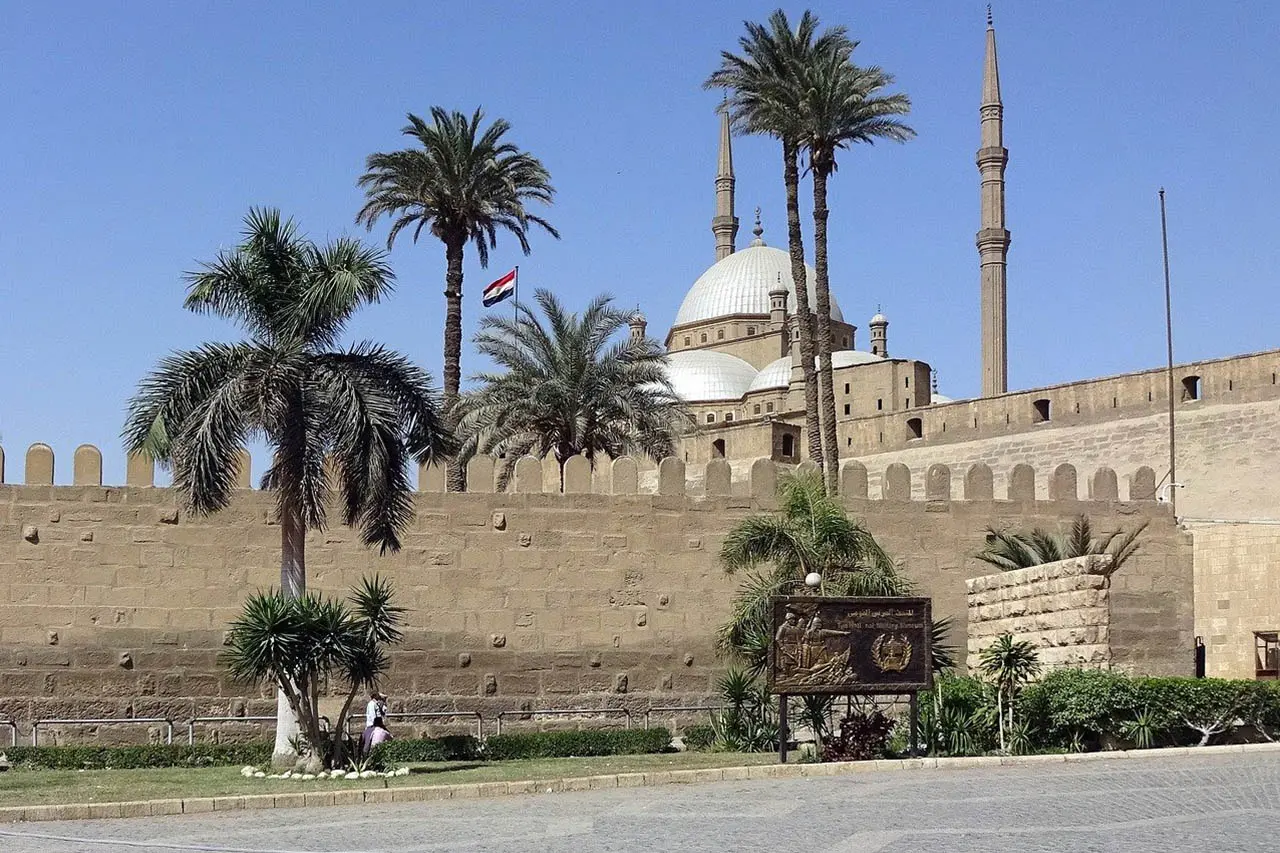
Audio 8 – Muhammad Ali Mosque:
Known as the Alabaster Mosque due to the material that covers it both inside and out, the Muhammad Ali Mosque is located on top of the Muqatam Mount, inside the Saladin Citadel. It was the largest mosque built in the first half of the 19th century and is also the most visible mosque in the Egyptian capital because of its elevated location and the height of its minarets.
The mosque was built between 1830 and 1857 under the commission of Muhammad Ali in memory of his eldest son, who died in 1816. Architect Yusuf Bushnak was inspired by the New Mosque in Istanbul for its design.
The mosque was built on the model of the Ottoman mosques, with a rectangular plan covered by a large central dome and several semi-domes framed by two delicate minarets.
The Alabaster Mosque is an oasis of calm in the middle of the bustling center of Cairo. Its extensive prayer hall is beautifully decorated: it has 100 stained glass windows on the walls and domes that create a beautiful effect inside. Sitting calmly on its carpets while admiring the hundreds of lamps on the ceiling is a moment you will surely keep in your memory.
If you access the courtyard, or "Al-Sahn," with the audio guide (audio guides, audio tour), you will discover the magnificent clock that Louis Philippe of France gave in exchange for the obelisk that was placed in the Place de la Concorde in Paris. Paradoxically, the clock was never used.
The founder of the building, Mehmet Ali, was originally buried in the courtyard of the mosque in a sarcophagus carved in Carrara marble, although the tomb with his remains was moved inside the temple in 1857.
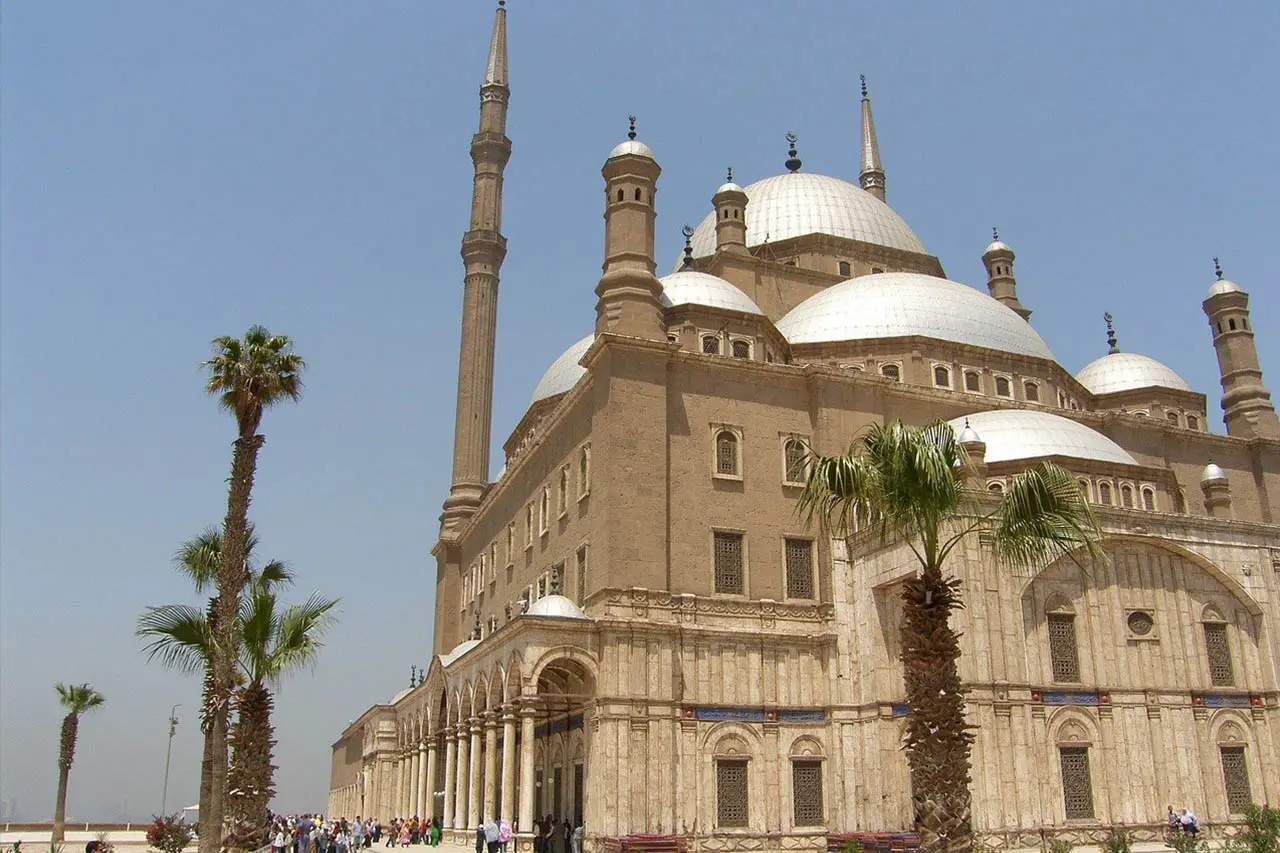
Audio 9 – the Mosque-Madrasa of Sultan Hassan:
Built in the mid-14th century under the commission of Sultan Hassan, the Sultan Hassan Mosque is considered the finest piece of architecture of the early Mamluk period, a time of great architectural splendor.
The building that you are now exploring with the audio guide (audio guides, audio tour) was built of stone and stands out both for its gigantic size and its innovative architectural elements. With an area of almost 8,000 square meters, it is one of the largest mosques in the world. The building is 35 meters high and its highest point is a minaret that rises 68 meters.
It was initially created to function as a madrasa, a school dedicated to the teaching of Islam that was divided into different sections to cover the four streams of Sunni thought: Shafi'i, Maliki, Hanafi and Hanbali.
During the construction work, one of the four minarets collapsed, causing the death of about 300 worshippers, something that was taken as a bad omen of the imminent fall of the state. The flamboyant and unpopular Sultan Hassan was assassinated 33 days after the minaret collapsed.
Behind the imposing, somber-looking, fortified entrance of the Sultan Hassan Mosque, a huge sun-drenched courtyard with a fountain in the center opens up, which is surrounded by the four halls of the different schools. The cloister features a mosaic floor that has the most spectacular design I have ever seen, unprecedented in Cairo.
The side rooms beautifully decorated with chandeliers hanging from long chains present different cells for students and teachers. Behind a bronze door decorated with stars is an exquisitely decorated mausoleum in which the son of Sultan Hassan was buried. The mihrab of this mausoleum is adorned with marble mosaics with elaborate geometric motifs.
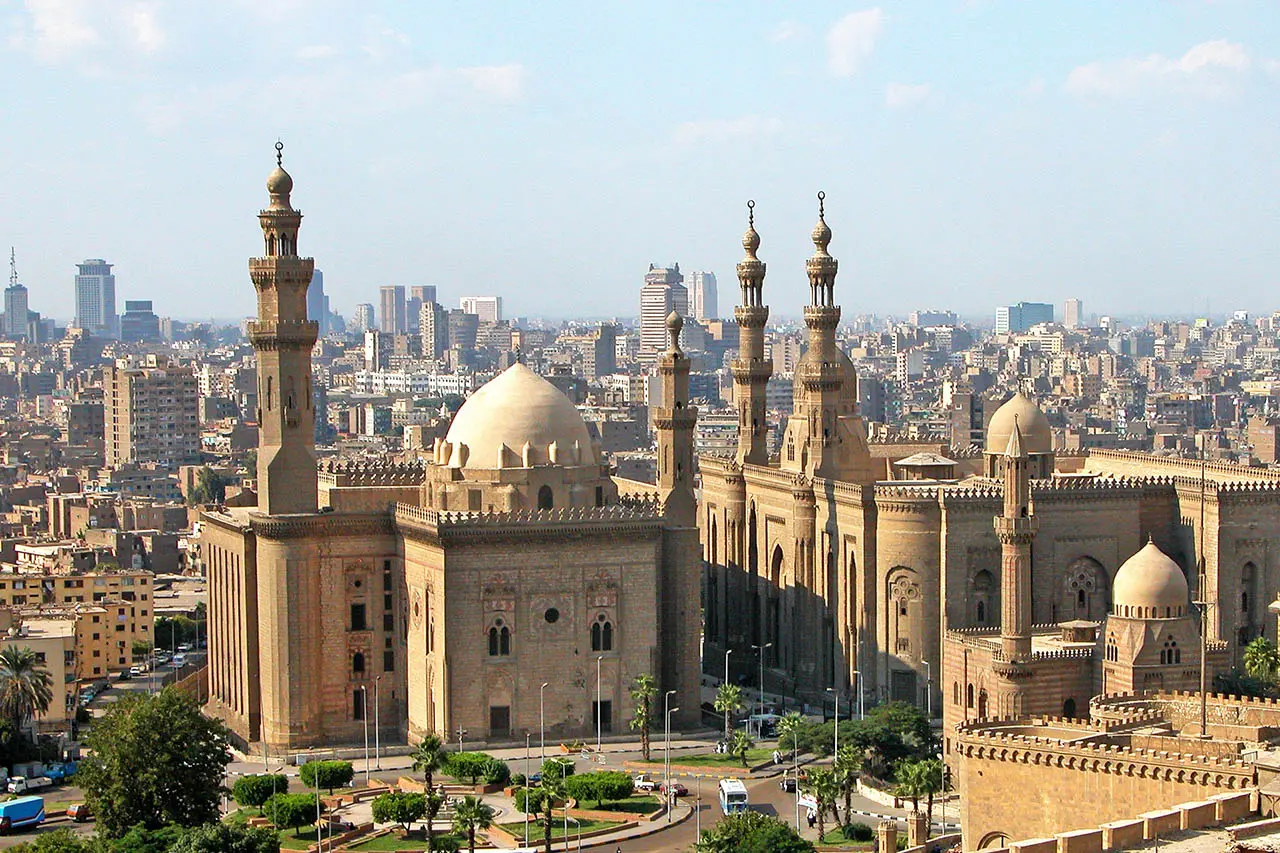
Audio 10 - Saqqara:
One of the many very valuable ancestral constructions in Egypt is Saqqara, an ancient complex that functioned as a burial place. Temples and tombs were built, as well as the step pyramid of Zoser: this is the first pyramid ever built and has remained to this day, which we will discover in the next section of the audio guide (audio guides, audio tour).
Saqqara is the site of the main necropolis of the city of Memphis, an important city and ancient capital of Egypt on the west bank of the Nile, located approximately thirty kilometers south of Cairo.
The ancient necropolises were located in this direction due to the belief that everything was in a renewable cycle and this was reflected in the solar cycle which rose in the east and set in the west. This led to consider the east as the world of the living and the west as the world of the dead.
Some texts mention the ancient Egyptians' belief in life after death and how the pharaoh is resurrected and ascends to heaven to live eternally among the gods, transfigured into a star. For this reason, the ancient Egyptians gave so much importance and devoted so much effort and money in the preparation of his tomb, because it was the beginning of a new path.
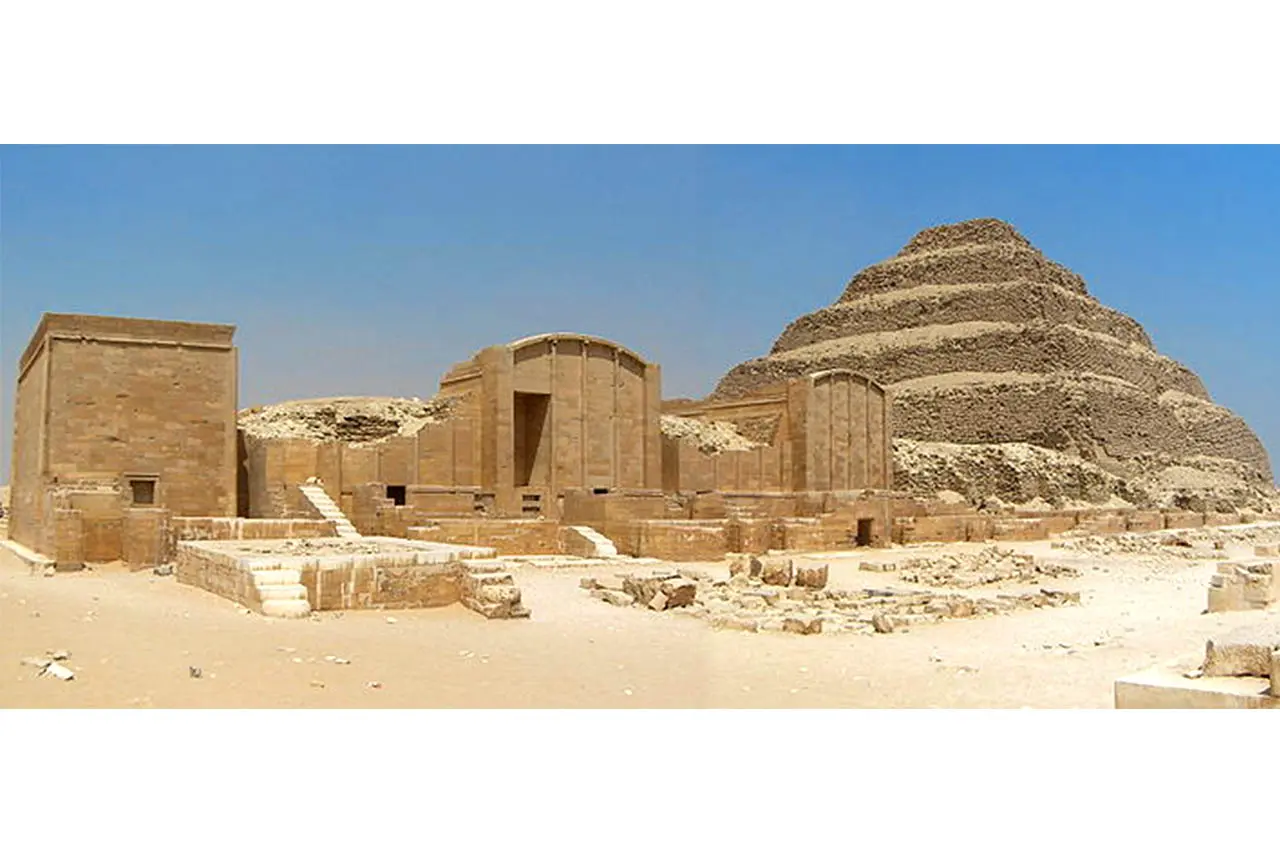
Audio 11 – the Step Pyramid of Zoser:
Until the construction of the pyramid of Zoser, royal tombs consisted of subterranean chambers covered by an adobe structure in the form of a truncated pyramid called a mastaba.
The Step Pyramid of Saqqara marks the beginning of a new style of construction, as it is considered the first pyramid in the world. Built by Imhotep, the first recognized architect in history, around 2,630 BC, the Step Pyramid is the most important place of the pharaoh's funerary complex. Like other pyramids, this one was built to serve as a tomb for the pharaoh who ordered its construction, Zoser, and to preserve his "essence" eternally. The pyramids were a way for the pharaoh to demonstrate his power to his people, and thus remain present after his death for eternity.
It is 60 meters high and consists of six superimposed levels, which decrease in size as they ascend. It is built entirely of limestone.
The importance of the pyramid of Zoser lies in having been the origin of the construction of the Pyramids of Giza and the rest of the Egyptian pyramids. Contemplating them accompanied by the audio guide (audio guides, audio tour), we can see the evolution of the skills and knowledge of the Egyptian people in the architecture and construction of the pyramids.
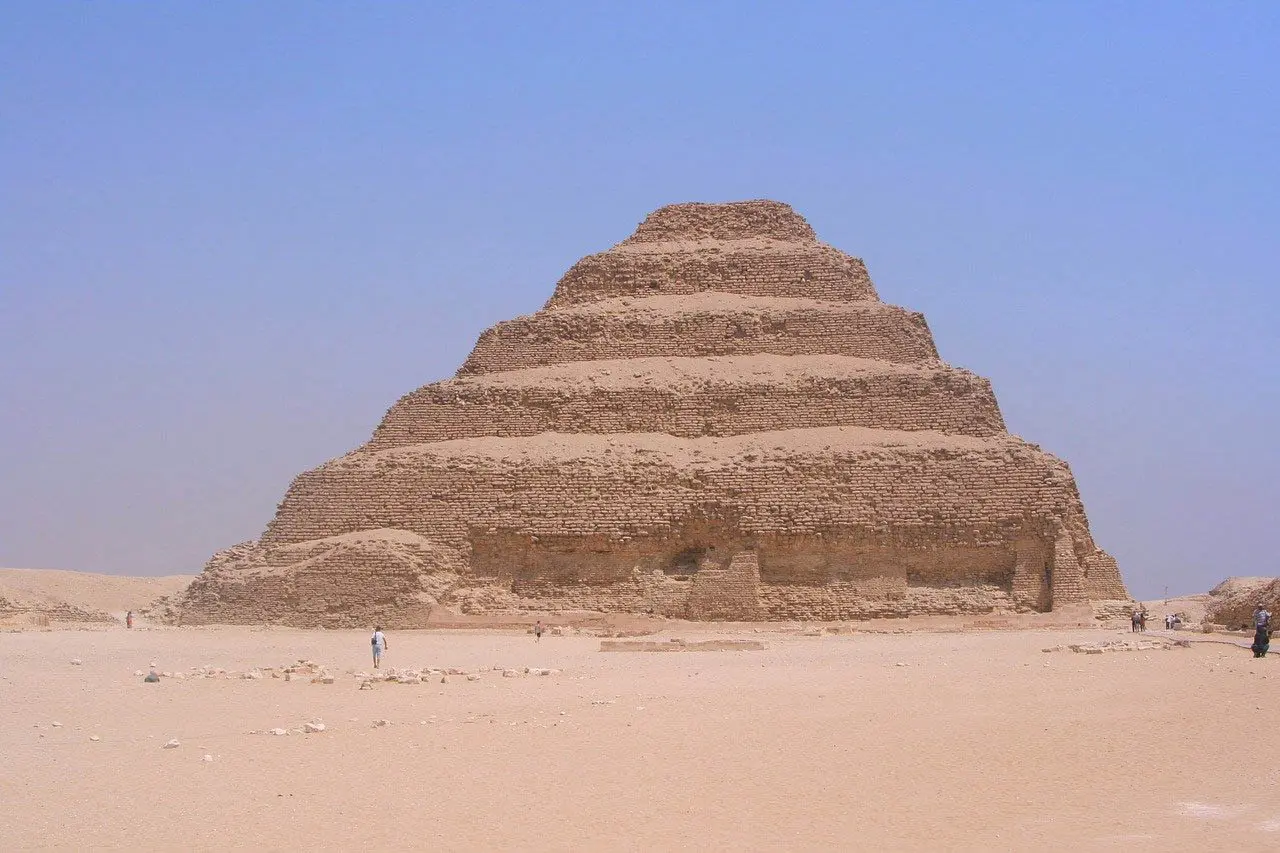
Audio 12 – the Hanging Church:
The next item on our audio guide (audio guides, audio tour) is of both tourist and religious interest: the Al-Muallaqa Church, or St. Mary's Church, which is also known as the Hanging Church. It is one of the most important Coptic monuments in Cairo.
Coptic means "Egyptian;" therefore Coptic Church refers to the Egyptian Orthodox Church. It was founded in Egypt in the 1st century and one of its peculiarities is that it has its own pope. It is estimated that the Coptic faithful number about 65 million people in the world, of which about 10 million are in Egypt. In the 11th century, the Hanging Church was designated as the official residence of the Coptic Orthodox Pope after the Muslim conquest of Egypt caused the Egyptian capital to be moved from Alexandria to Cairo.
The name Hanging Church is due to the fact that its main nave was built over the south gate of what was once the Roman fortress of Babylon, a unique location that gave the church the impression of being suspended in the air.
Although the exact date of its construction is not known, there are references to it as early as the 3rd century A.D. During the 14th and 15th centuries it was known among pilgrims as "the church of the stairway," due to the 29 steps that must be climbed to gain access to its interior. The ground level has risen six meters since Roman times, so that the tower is mostly buried, making the elevated position of the church less noticeable.
One of the most notable features of the Hanging Church is the ceiling, which is constructed of vaulted wood and recreates the interior of Noah's Ark. Another highlight is the marble pulpit, which is supported by 13 marble columns meant to depict Jesus and his 12 disciples. One of the columns is black, portraying Judas' betrayal; while another is gray, to represent Thomas' doubt upon learning of the resurrection. However, the church is perhaps most famous for its religious icons, the oldest and most famous of which is known as the Coptic Mona Lisa. It depicts the Virgin Mary and dates from the 8th century.
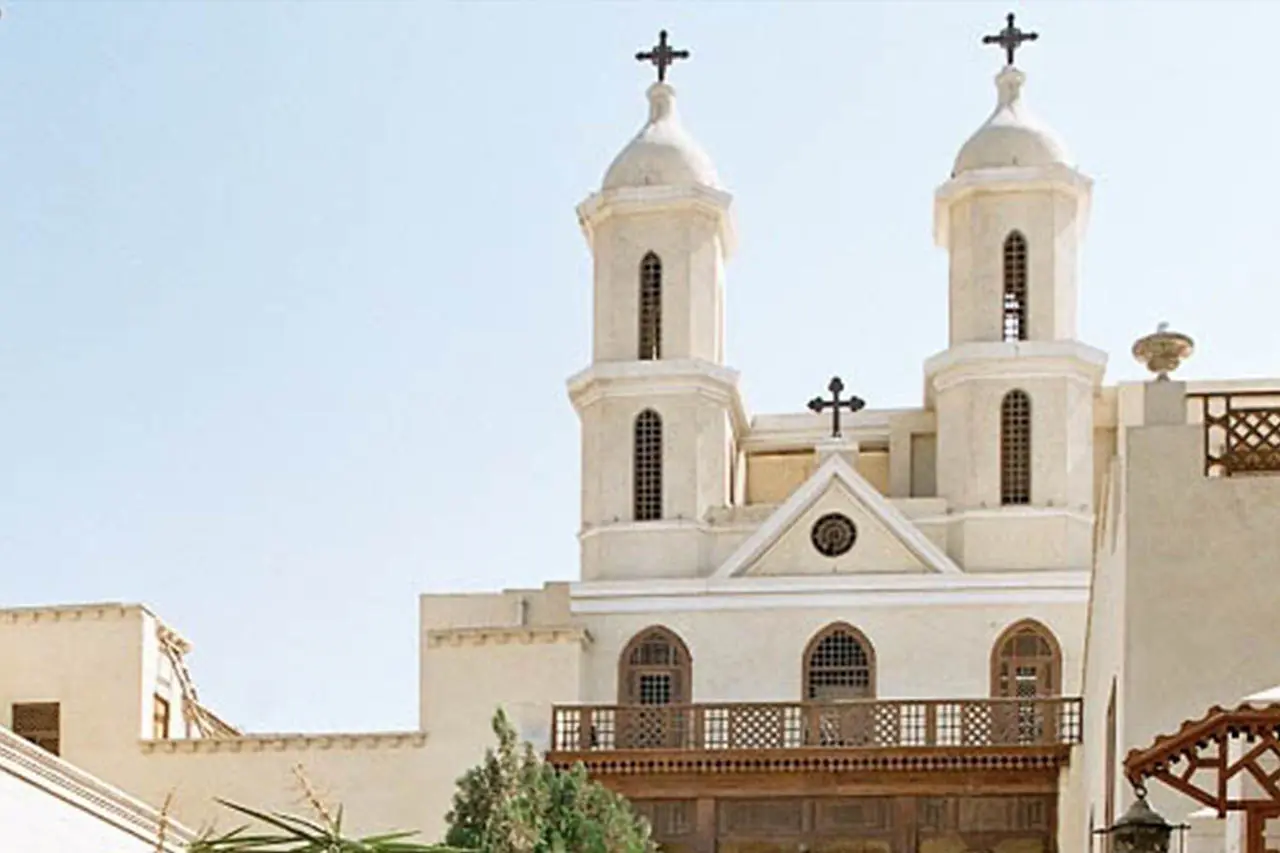
Audio 13 – the Red Pyramid:
If you dare to travel 40 kilometers south of Cairo with the audio guide (audio guides, audio tour), you can explore the Red Pyramid, which is the third-largest pyramid in Egypt. It was built by the fourth dynasty pharaoh Seneferu to be his tomb. Local residents refer to the Red Pyramid as el-Haram el-Watwat, which means "the blind pyramid."
It owes its present name to the reddish color of the stone blocks of its core, although it was not always this color. Originally it was covered with white limestone blocks, which were later used to build the buildings of Cairo, exposing the reddish color of the pyramid.
It represents the first successful attempt to erect a smooth-sided pyramid, being the tallest construction in the world at the time. It was built at the same 43° angle as the upper section of the right-angled pyramid, which gives it a noticeably flattened appearance compared to other Egyptian pyramids.
Archaeologists speculate that the reason for this tilt may be that the first pyramid ever built, the pyramid of Meidum, collapsed after its construction: the architects of the time therefore modified the tilt of the second pyramid, called the bent pyramid, in the middle of its construction, as it showed signs of instability, so the angle of inclination was altered from 54° to 43° halfway through its construction.
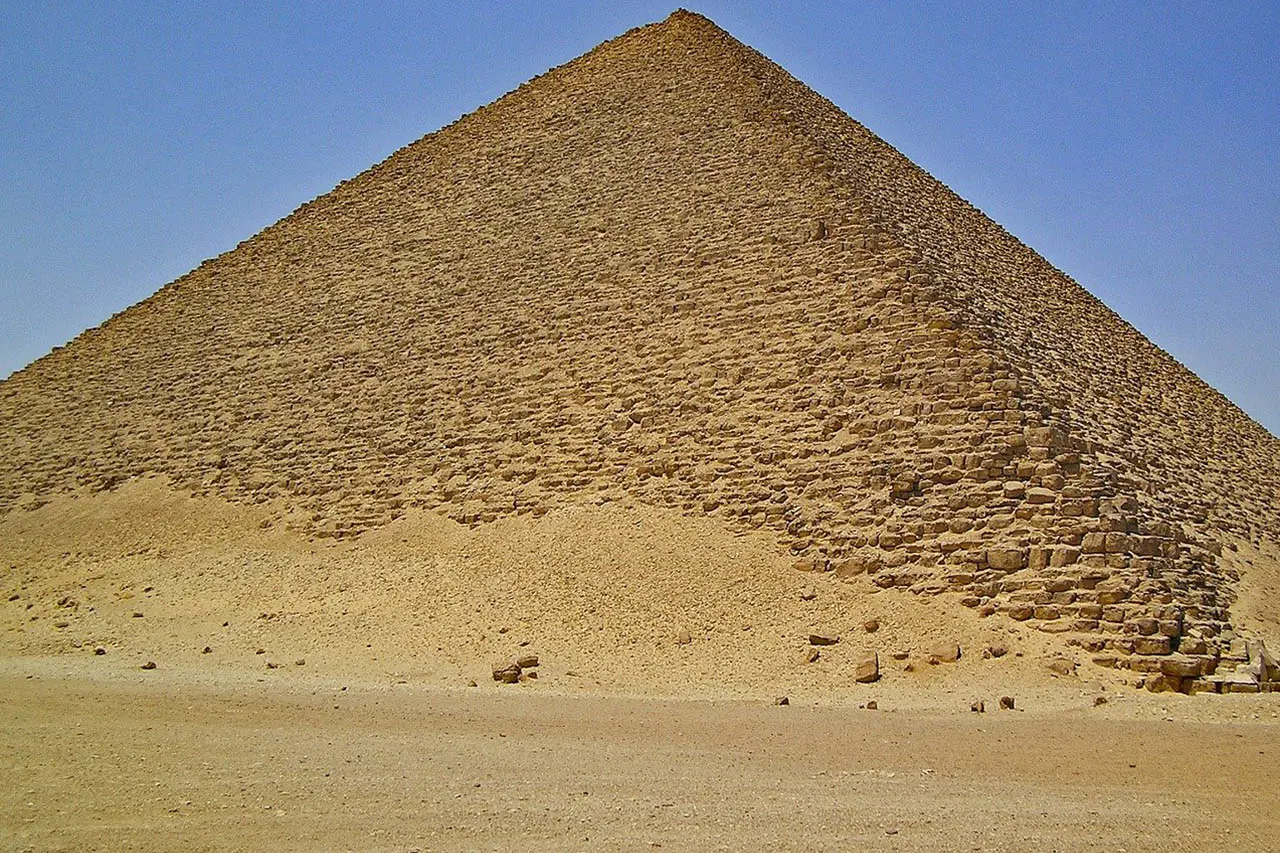
Audio 14 – the Mosque of Ibn Tulun:
The Ibn Tulun Mosque is the oldest mosque in the city, dating back to 879, and currently retains its original features.
The structure of the Ibn Tulun Mosque is of impressive proportions, and is one of the largest mosques in Cairo, but also one of the simplest constructions: made of mud bricks and wood, it is very simply decorated in a classic Islamic architectural scheme.
It has a huge courtyard of 90 square meters that gives it tranquility, being a fabulous haven of peace in the middle of the bustle of the city. In turn, this courtyard is surrounded by a series of arches that give access to the prayer room.
According to historians, Ahmad Ibn Tulum was a slave of Turkish origin who gradually rose to power and created the Tulunid dynasty. After founding the primitive city of al-Qata'i, he commissioned the construction of this mosque that would bear his name. The mosque always remained intact even though the city was destroyed, being replaced by the present city of Al Qahirah, Cairo.
The mosque is certainly striking for its decorative elements, but also for its stupendous spiral stepped minaret, modeled after the Great Mosque in the Iraqi city of Samarra. It is accessed by an external spiral staircase, and we recommend that you go up with the audio guide (audio guides, audio tour) to see the city from its height, as it offers spectacular panoramic views.
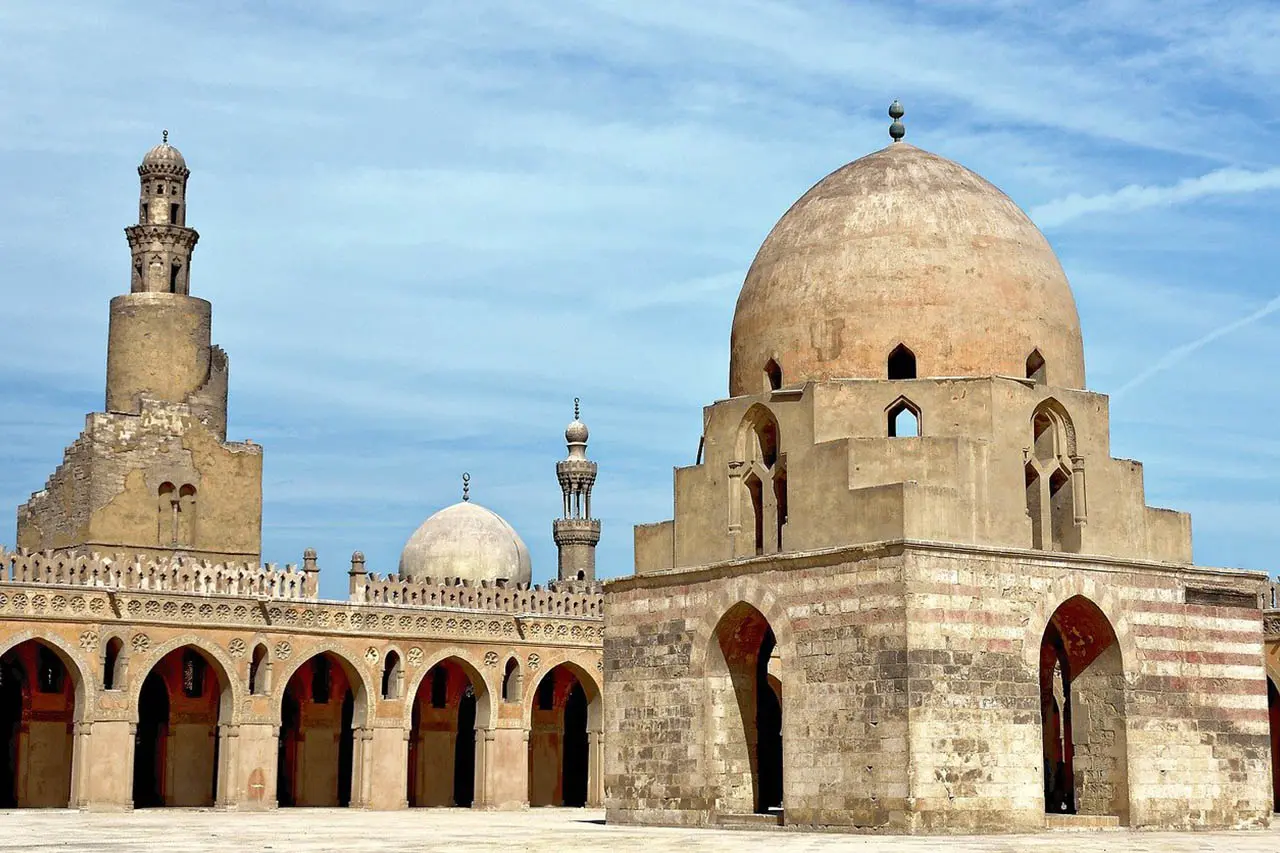
Audio 15 – Tahrir Square
Tahrir Square is located at the western end of the historic Qasr al-Ayn Street and near the Qasr al-Nil Bridge, which crosses the Nile River. Surrounding the square are several important monuments, such as the Egyptian Museum described earlier in the audio guide (audio guides, audio tour).
The square was originally called "Midan Ismailia," after the rule of Viceroy Ismail, who promoted the new design of Cairo's urban center. After Egypt's 1952 Revolution, which transformed the country from a constitutional monarchy into a republic, the square was renamed "Midan Tahrir" or Liberation Square.
In the square, there is a statue of Sheikh Umar Makram bin Hussien al-Sayouti, an Egyptian politician who played a major role in the resistance against the invasion of Napoleon's French troops in 1798.
Liberation Square has witnessed numerous protests and demonstrations over the years, including the 1977 and 2003 protests, the latter against the Iraq War, and the so-called "third Egyptian revolution" of 2011, a major political crisis that led to the resignation of President Hosni Mubarak.

Audio 16 – Gezira Island:
Gezira Island emerges from the waters of the Nile in the center of Cairo. It has a very elegant residential district and is home to many of the country's foreign embassies.
It remained uninhabited until 1830, when Mehmet Ali had a palace built in the northern part. Later, Ismail Pasha decided to build a splendid summer palace in 1869. Legend has it that it was designed for 3 of the 14 women of the harem, but in reality, the palace was built primarily for the guests who attended the opening ceremony of the Suez Canal, including the Empress Eugénie de Montijo and her husband, Napoleon III. Subsequently some wealthy families from Cairo built lodgings on the island. In the second half of the 19th century it became one of the most prestigious areas of the city.
The atmosphere in Gezira is cosmopolitan and modern. On the island you will find many opportunities for entertainment both day and night, with excellent restaurants offering entertainment. It is also home to one of the city's most elegant residential neighborhoods, Zamalek.
There are six bridges connecting the island to the mainland. Instead of accessing the island on foot or by cab, you can choose to cross the river to the other side in faluccas, typical Egyptian boats.
Take advantage of your visit to Gezira Island to discover the next stop on the audio guide (audio guides, audio tour): the Cairo Tower.

Audio 17 – The Cairo Tower:
The next stop on the audio guide (audio guides, audio tour), the Cairo Tower is a telecommunications tower built in the modern district of Zamalek, along the Nile River, in the northern part of Gezira Island. It was built between 1954 and 1961.
The tower is topped by a circular observation deck and a revolving restaurant overlooking Greater Cairo. A tour lasts approximately seventy minutes.
At 187 meters high, and with a total of 90 floors, the Cairo Tower is 43 m higher than the Great Pyramid of Giza, making it the tallest structure in Cairo. It is also the tallest structure in North Africa. Until the opening of the Hillbrow Tower in Johannesburg in 1971, it was also the tallest building on the entire African continent.
The tower was designed by Egyptian architect Naoum Chebib. Its design evokes the lotus plant, a popular motif used by ancient Egyptians to symbolize the sun, creation and rebirth. The base of the tower and the main staircase are carved from polished pink Aswan granite, a material frequently used by ancient Egyptian architects. On the exterior, a layer of 8 million small mosaics provides protection from the elements.
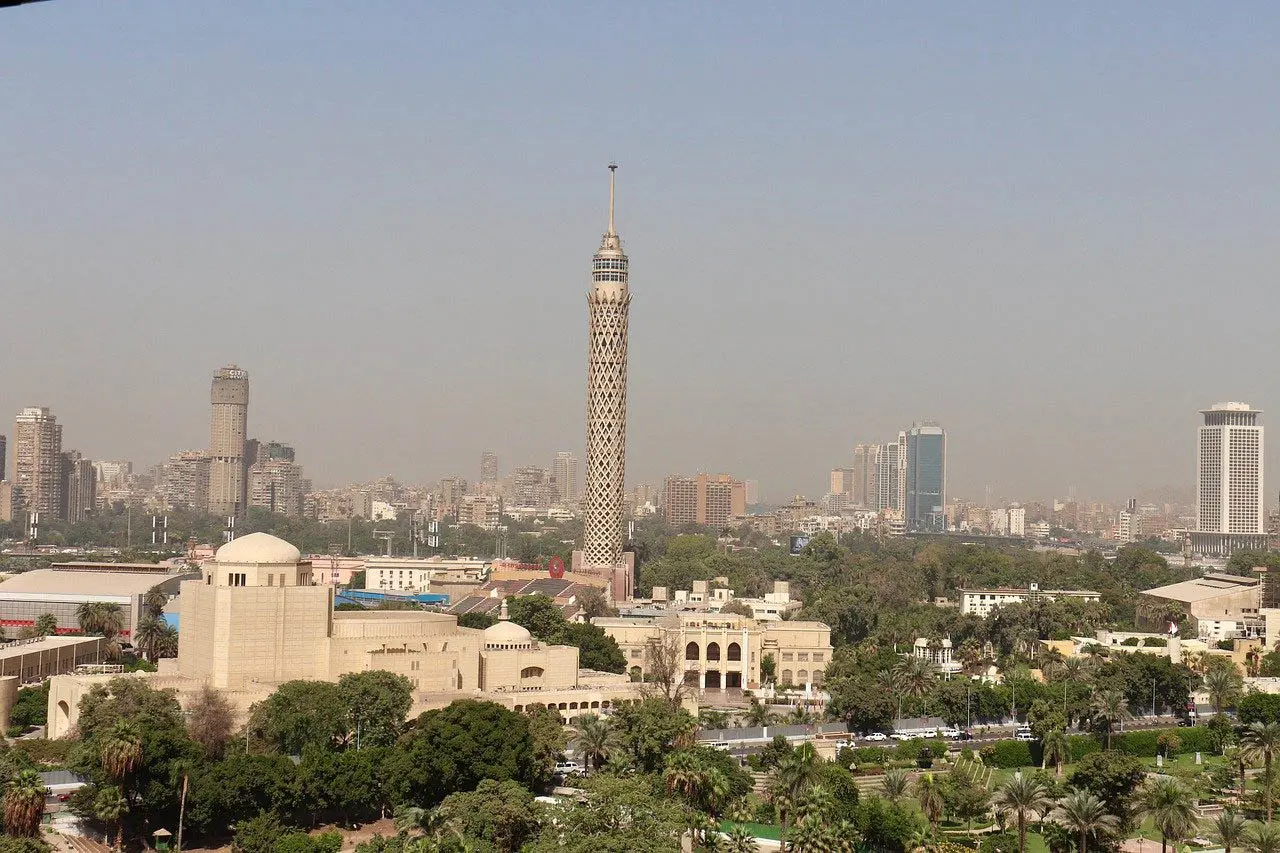
Audio 18 – Al-Hakim Mosque:
One of the oldest mosques in Cairo, the Al Hakim Mosque is located in the heart of the old Islamic quarter of the city. Commissioned by the caliph Al-Hakim Bi Amrillah, and built between 990 and 1013, it is a symbol to an expanding Islam.
Designed in the Fatimid style, the Al Hakim Mosque was originally built outside Cairo before being incorporated into the city walls in 1087. At different times, it was used as a prison for the Latin crusaders during the Crusades, and also as stables, school, and fortress by Napoleon. It was finally in 1980 that it was intensively renovated and converted back into a mosque.
Among its most remarkable elements are the courtyard with its arcades, its large entrance gate, and above all, its minarets, located on each side of the façade, which are the oldest surviving minarets in all of Cairo.
Fragments of hieroglyphic inscriptions were found on some walls, and even the relief figure of a hippopotamus, proving that the first fortresses of Cairo were built with stones taken from the ruins of the ancient capital, Memphis.
The decoration of the mosque is rich and diverse. Despite the renovations, remains of the original decoration can still be seen – stucco carvings, wooden beams, and numerous Qur'anic inscriptions dating from the reign of al-Hâkim, sculpted in florid kufic, a calligraphy that was used at different times, both in Spain and in Iran and Anatolia.
Here ends the audio guide (audio guides, audio tour). We hope you will take away unforgettable memories of your visit to Cairo!
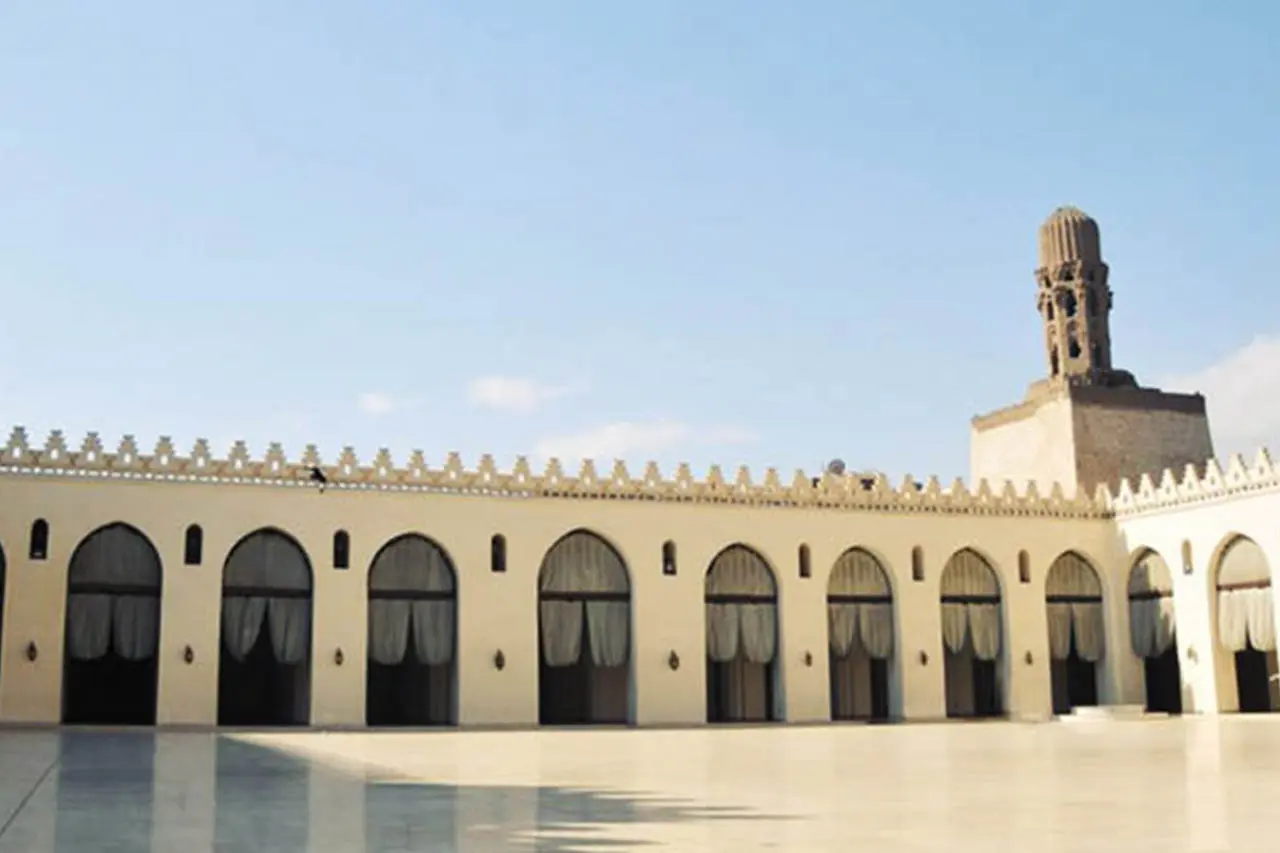
Audio guide devices, Multimedia audio guides,
Audio guide GPS tourist bus-train, charging bases and accessories.
Group guidance systems, headsets, charging cases, tour guide systems accessories.
Audioguides available from mobile devices, web App, downloadable App from Google Store.
Audioguides in several languages, translations, voiceovers. Audio descriptions, signoguides, visual contents for audioguides. 3D Reality.